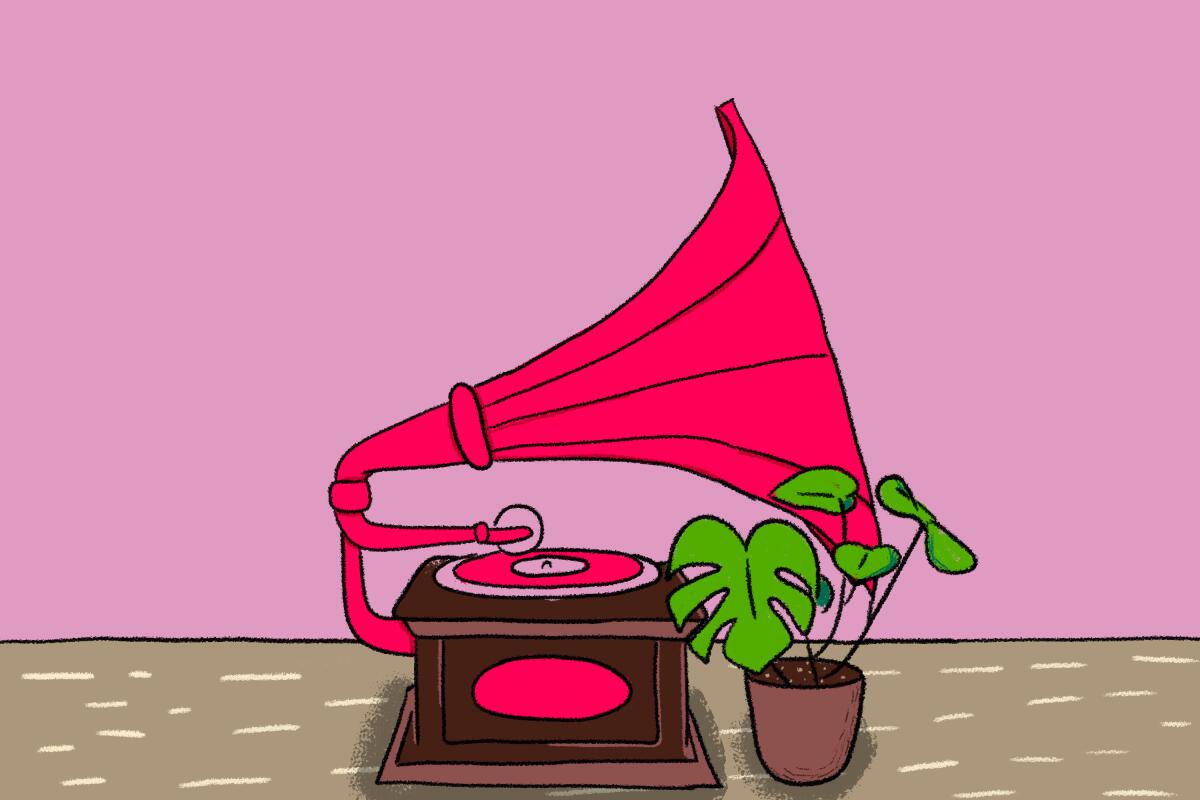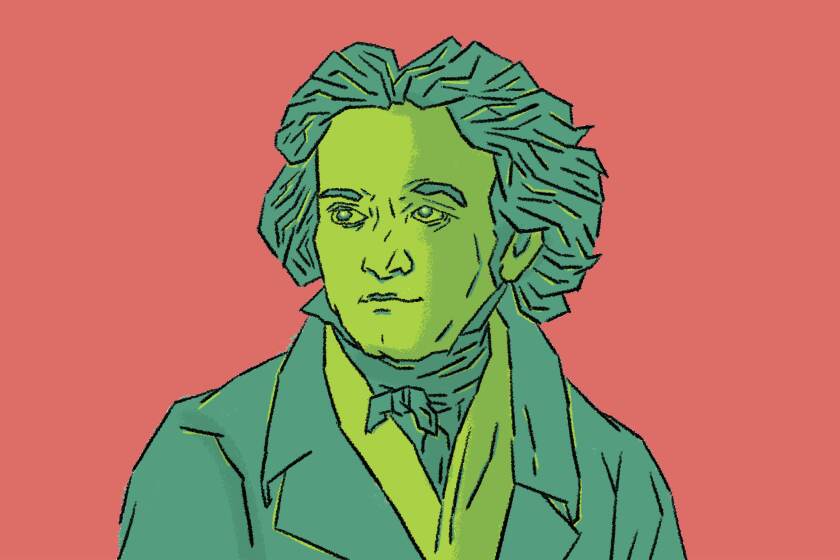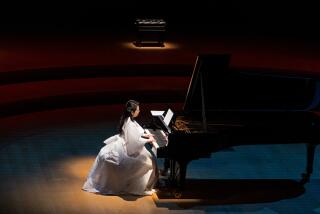How to Listen: A classical music series to open our ears in a COVID-quieted world

Concert halls may be silenced, but there are still ways for music to be a communal experience. This series aims to be one.
- Share via
On a sunny day just after the summer solstice in Perugia, Italy, and two months before his death in 1992, John Cage was seated in the medieval city hall explaining to an indignant woman how to listen to his chance-derived music, which made absolutely no sense to her. I happened to be with him, leafing through the Corriere dell’Umbria looking for a report about the Cage festival and conference in the Umbrian capital.
The composer borrowed the newspaper and held the front page up on the table, as though it were a curtain. He then placed objects, one by one, behind the sheet. For each — an assistant’s notepad, his hotel keys, his Bulova skeleton watch, his glasses, my fountain pen — Cage ceremoniously lifted the paper for a few seconds, then lowered it again.
Think of every sound being like that, he explained. If you don’t know what to expect, you see everything as if never before, and with new eyes. Everything is interesting.
“Mamma mia!” the woman exclaimed. Cage laughed his contagious laugh, and she delightedly hugged him.
During our many weeks of lockdown, there had been much comment about the world becoming a kind of Cage stage, a planet in pandemic dramatically quieted. We newly marveled at birdsong we never heard before outside our windows. This was said to be just the exercise in awareness that Cage had intended in his seminal silent piece, “4’33”,” in which a performer makes no sound for that prescribed time, directing the audience’s attention to the environment instead.
But the imposed silence of our pandemic proved not always welcome. Neighbors became newly annoying, children demanding. During the peak of COVID-19 cases in New York City, friends told me of the terrible sensation of ambulance sirens breaking the eerie quiet of the streets every few minutes.
Even as the situation has vastly improved in Manhattan, people still complain of not sleeping. In his recent “A Primer for Forgetting,” Lewis Hyde described insomnia as “the too-much-memory disease.”
Then came the overpowering shock of the eight minutes and 46 seconds of silence the Rev. Al Sharpton directed mourners to observe at the funeral of George Floyd. Here, it was a reflection on the horrifying time Floyd was held to the ground and killed by Minneapolis police.
Is this, too, music? Every sound heard during that silence at the funeral and at every other eight-minute, 46-second memorial elsewhere became the notes of a requiem. Cage’s revelation is that there is no such thing as silence. Every sound is a living thing, a reminder of life being lived. And listening must always be in the ear of the beholder.
All in all, this has been an exceedingly strange time for music. Cage is also remembered for famously saying that nothing is accomplished by writing, performing or listening to a piece of music, and consequently our ears are in very good shape. Well, maybe they are, but during lockdown and now during the uncertain reopening of the country, music we know and love, along with once-loved music rediscovered, has been served up as comfort food, as a source to energize us, numb us, enlighten us, entertain us.
Bach, in particular, provided an incomparable source of refuge. In Brian Lauritzen’s “At Home” series on KUSC-FM, John Adams — isolated in his secluded Sonoma County composer’s hut writing an opera based on Shakespeare’s “Antony and Cleopatra” — drew listeners to the sublime surety of Icelandic pianist Víkingur Ólafsson’s bestselling Bach recording. Meanwhile, for his “How to Think Like Bach” program, pianist Jeremy Denk invited neuroscientist Daniel Levitin to discuss how Bach’s ingenious resolution of dissonance might be something that can help the brain build neural bridges toward the optimism we desperately need to get through the day.
During the period of protest that followed, comfort became controversial. Dissonance was hailed as what we needed to understand what it takes for the oppressed to get through every day. Remembering and forgetting have gotten confused, suggesting two seemingly extreme ways of listening.
In forgetting, we get new ideas and, thus, new beginnings. In remembering, the path is through patterning. We celebrate either chaos or order, narrative or non-narrative, compelling emotion or illuminating abstraction, familiarity or novelty. We are given the choice of either embracing the proven past or, to quote the rest of the title of Hyde’s capriciously edifying new book, “Getting Past the Past.”
The great lesson of this huge cultural lesion in our midst is that we have no idea of what a “new normal” actually means. Each passing day offers surprises, new thoughts, fleeting revelations. Music plays a role in this. We continue to listen. And we take cues from what we hear, sometimes from discovery of something new, sometimes from hearing the familiar filtered through newly unfamiliar states of mind. We listen to confirm our moods and to change our moods.
Coronavirus may have silenced our symphony halls, taking away the essential communal experience of the concert as we know it, but The Times invites you to join us on a different kind of shared journey: a new series on listening.
What has changed most radically since the coronavirus outbreak, though, is where and with whom and under what circumstances we listen. Listening and making music have become much more private. The communal experience of making and receiving music has been lost.
It may be a year from Monday before concert life as we know it can resume, and if we turn to Cage’s book “A Year From Monday,” he offers his answer to the question: What shall I do to enjoy music?
“There’re many ways to help you. I’d give you a lift, for instance, if you were going in my direction, but the last thing I’d do would be to tell you how to use your own aesthetic facilities.”
With so little hope for live music on any reasonable scale to return for months, this seems a time to explore a number of individual works — from the Middle Ages to this muddled age, famous and obscure, from varied composers in equally varied genres. This series aims to suggest ways to listen, to offer reasons to listen or simply to open ears to whatever the sonic cat might drag in.
The largest body of music, culturally and historically, is classical. It’s a meaningless genre heading that can include a Bach meditation on death (the cantata “Es ist genug”) or Pauline Oliveros’ deep sonic thoughts with her accordion (“The Well & the Gentle”). It may reflect the African American experience through the omnivorous ears of Italian avant-garde composer Luciano Berio (“Sinfonia”) or George Lewis’ collaboration with iconic figures of jazz (“Shadowgraph, 5”). Music can be intended to glorify God sensually with four male voices in an incense-filled Gothic cathedral (Machaut’s “Messe de Notre Dame”) or ecstatically on a stage large enough to hold a 1,000-strong chorus and orchestra (Mahler’s Symphony No. 8). Music can be a melding of East and West (Toru Takemitsu’s “November Step”) or a place imagined free from imposed patriarchy (Olga Neuwirth’s “Masaot/Clocks Without Hand”) or an extreme fusion of Latin, Middle Eastern and whatnot influences (Osvaldo Golijov’s “Ayre”).
The real challenge for listeners is to overcome the worry of how much you know. Music is in one sense overrated as a universal language, given the requirements necessary for understanding its specific grammar, syntax and cultural context. There is ever the fascination with knowing how a piece of music — or anything — is made, be it the arithmetic additive rhythms in Philip Glass’ music or the chance procedures in Cage. Think of how radically dissimilar is the mindset required for hip hop and Gagaku, the ancient Japanese court music.
For all his liberation of the ear, Cage was an inveterate storyteller who often explained one of his insurgently non-narrative pieces with a memorable story. That is to say, every piece worth hearing has a story and doesn’t need one. Listening can be both following and forgetting, understanding and welcoming misunderstanding, overpowering the emotions and discounting them — often and in the best pieces, all at the same time. The evolution of what we call classical music through the millennia incorporates much of what it is like to live the life we do.
A year from Monday is a long time. I invite you to join me on a wild ride through a quirky selection of pieces, each of which, I like to think, has the promise to make the world feel a little fuller.
Support our coverage of the arts. Become a digital subscriber.
Beethoven’s A-minor String Quartet chronicles the composer’s illness and recovery. Nearly 200 years later, it’s a sonic window into our coronavirus world.
More to Read
The biggest entertainment stories
Get our big stories about Hollywood, film, television, music, arts, culture and more right in your inbox as soon as they publish.
You may occasionally receive promotional content from the Los Angeles Times.













